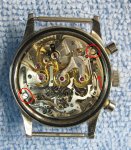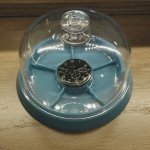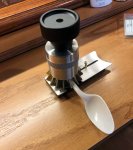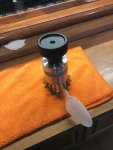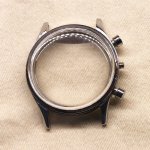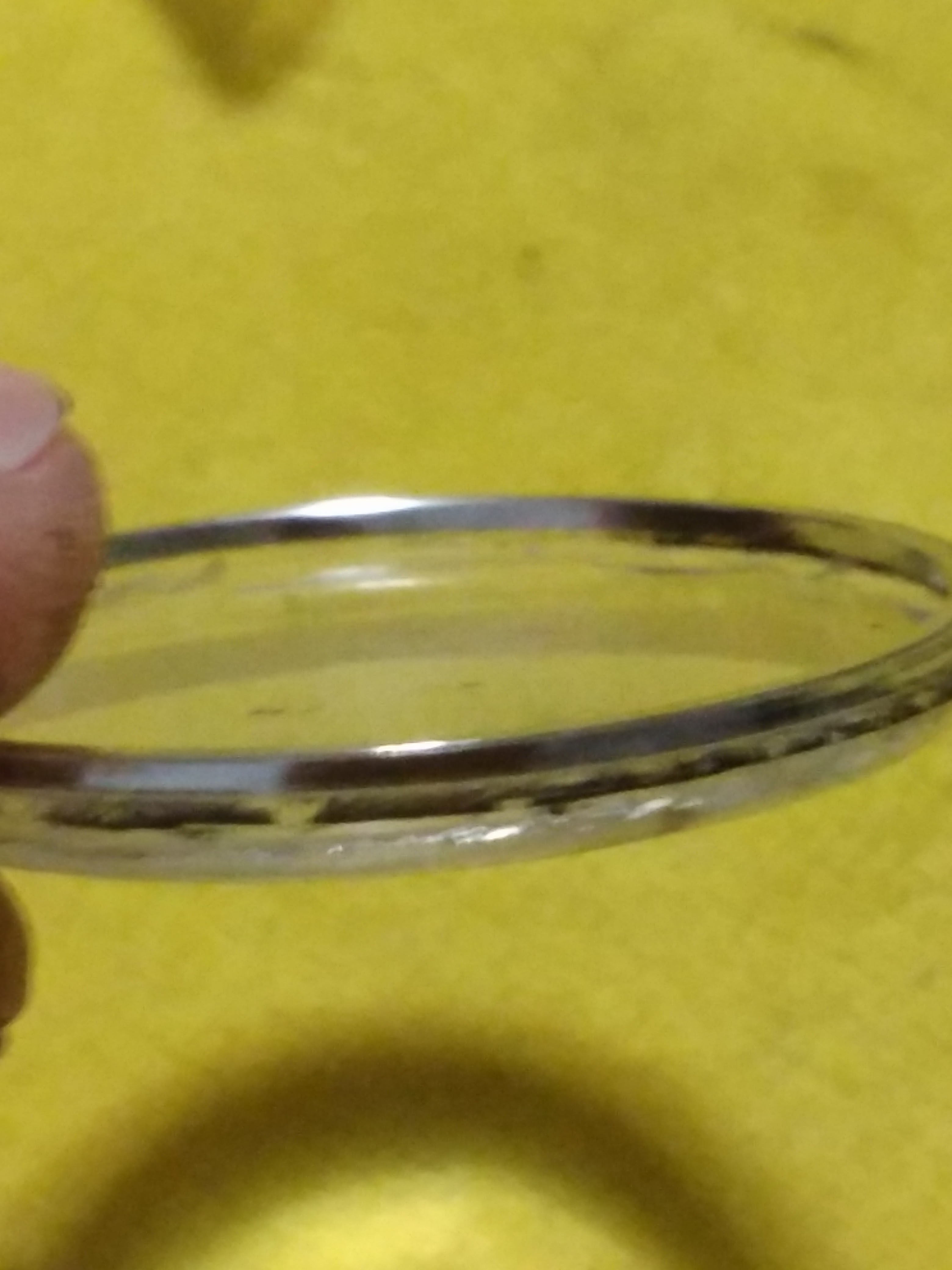Part One:
I mentioned in the "A Little Work on my Id Graph" thread that I summoned the nerve to open up the watch and blow out a previously discovered bit of debris after having successfully replaced a crystal on my Gallet MC12H "Evil Snow White," another of my favorite watches.
For those of you who read this and have a scratch or a nick on a crystal that won't polish out - or worse yet - a crack, and who have no experience working on a watch, I am here to convince you that you too can change the crystal yourself if you choose to do so.
It'll take some special tools to do the job, but these tools will likely cost less than 100 USD if purchased new . . . and then you have them for that one other time in your life when you may need them again.
Now the story unfolds . . .
I sent my Gallet "ESW" out to RGM to have a full service performed and when I got it back, it was running like a new watch (as measured with the timegrapher,) and it looked a treat:
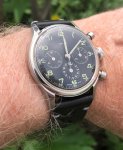
But . . .
Not for long . . .
One day not long after getting the watch back, I dropped it from a height of about three feet while standing in a doorway, and the watch landed face down on a hardwood door saddle.
I neglected to take a photo of the watch with the shattered crystal still in place, but here is what the crystal looked like off the watch:
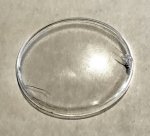
I was very lucky in one respect . . .
The crystal must have absorbed much of the shock because, when I put the watch back on the timegrapher, the performance numbers had not changed. The watch remained adjusted in various positions; the beat amplitude still hit 345 degrees and the beat error was still 0.0 to 0.2 msecs depending upon position.
This could be an Incabloc testimonial
Landing on the crystal also meant that there was no damage to the case.
Lesson learned. Next time any of us drops a watch, please let's be sure that it lands squarely on the crystal!
So how did I manage to drop the watch?
. . . a digression . . .
The watches that I own with leather straps are each equipped with very fine butterfly deployant clasps which I purchase from Bob Davis at RHD. One of the reasons why a deployant clasp is such a nice accessory to use is that, the watch strap always forms a closed loop. It is difficult to drop a watch that is on a deployant clasp. One has to work very hard to do so.
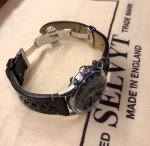
When one wears a watch with a leather strap and buckle, for a short period of time as one puts on the watch there is opportunity to drop the watch. I reckon we've all learned to put on our watches while leaning over a soft surface not far beneath the watch. But buckling the strap also puts a crease in the strap each time and this bending of the strap can be greatly reduced when using the deployant clasp.
Butterfly clasps like the ones shown here are also more comfortable when compared with the single fold-over type.
I probably have a dozen RHD clasps, but the one I have on the "ESW" had a bit of a loose fit to where the clasp clips to the strap attached to the 6 o'clock side of the watch. It would have been very easy to adjust, and believe me, the spring tension of the slots shown with arrows at the right have been recently adjusted!
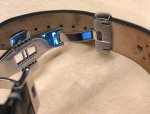

This one clasp was received with a loose fit to the above clamp. I was aware of it when I received it and I intended to add a bit of tension to the clasp, but I neglected to do so and the clamp opened while I was sliding the watch over my wrist.
No other clasps that I own needed adjustment . . . except for this one.
Part Two will show how a compression fit crystal is replaced.
I mentioned in the "A Little Work on my Id Graph" thread that I summoned the nerve to open up the watch and blow out a previously discovered bit of debris after having successfully replaced a crystal on my Gallet MC12H "Evil Snow White," another of my favorite watches.
For those of you who read this and have a scratch or a nick on a crystal that won't polish out - or worse yet - a crack, and who have no experience working on a watch, I am here to convince you that you too can change the crystal yourself if you choose to do so.
It'll take some special tools to do the job, but these tools will likely cost less than 100 USD if purchased new . . . and then you have them for that one other time in your life when you may need them again.
Now the story unfolds . . .
I sent my Gallet "ESW" out to RGM to have a full service performed and when I got it back, it was running like a new watch (as measured with the timegrapher,) and it looked a treat:

But . . .
Not for long . . .
One day not long after getting the watch back, I dropped it from a height of about three feet while standing in a doorway, and the watch landed face down on a hardwood door saddle.
I neglected to take a photo of the watch with the shattered crystal still in place, but here is what the crystal looked like off the watch:

I was very lucky in one respect . . .
The crystal must have absorbed much of the shock because, when I put the watch back on the timegrapher, the performance numbers had not changed. The watch remained adjusted in various positions; the beat amplitude still hit 345 degrees and the beat error was still 0.0 to 0.2 msecs depending upon position.
This could be an Incabloc testimonial
Landing on the crystal also meant that there was no damage to the case.
Lesson learned. Next time any of us drops a watch, please let's be sure that it lands squarely on the crystal!
So how did I manage to drop the watch?
. . . a digression . . .
The watches that I own with leather straps are each equipped with very fine butterfly deployant clasps which I purchase from Bob Davis at RHD. One of the reasons why a deployant clasp is such a nice accessory to use is that, the watch strap always forms a closed loop. It is difficult to drop a watch that is on a deployant clasp. One has to work very hard to do so.

When one wears a watch with a leather strap and buckle, for a short period of time as one puts on the watch there is opportunity to drop the watch. I reckon we've all learned to put on our watches while leaning over a soft surface not far beneath the watch. But buckling the strap also puts a crease in the strap each time and this bending of the strap can be greatly reduced when using the deployant clasp.
Butterfly clasps like the ones shown here are also more comfortable when compared with the single fold-over type.
I probably have a dozen RHD clasps, but the one I have on the "ESW" had a bit of a loose fit to where the clasp clips to the strap attached to the 6 o'clock side of the watch. It would have been very easy to adjust, and believe me, the spring tension of the slots shown with arrows at the right have been recently adjusted!


This one clasp was received with a loose fit to the above clamp. I was aware of it when I received it and I intended to add a bit of tension to the clasp, but I neglected to do so and the clamp opened while I was sliding the watch over my wrist.
No other clasps that I own needed adjustment . . . except for this one.
Part Two will show how a compression fit crystal is replaced.
Last edited:

